Text
King and his mother?!
In Christ's College Chapel, Cambridge is 16th century stained glass window, a rare example which survived nearly intact. It is thought to be done in 1505. On left is Henry VII. And the woman on right is Margaret Beaufort. In the most unexpected outfit.
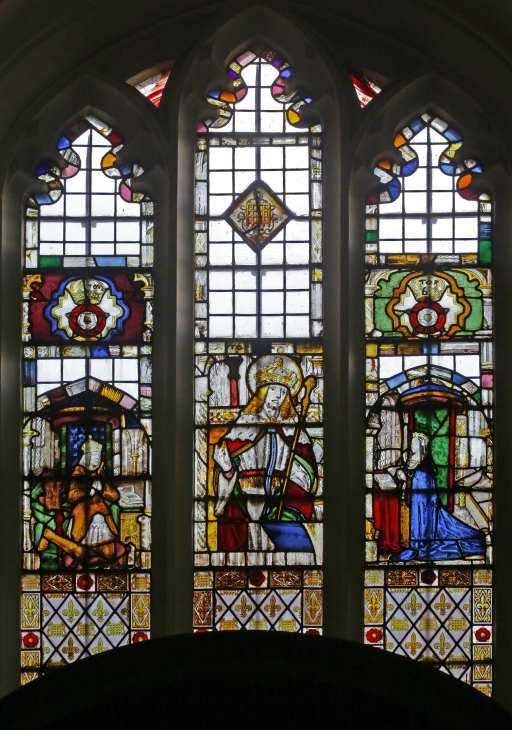
Read further for more.
In middle is St. Edward the Confessor,

on left King Henry VII wearing his armour and crown, already grey-haired.

i just love the silvery part of his armour and also these portculises.
Green behind him probably has to do with tudor colours-green and white.
But it is the female figure on right which caught my attention. It is said to be lady Margaret Beaufort, who was very involved with Christ's College in 1505. Hence it is very logical to asume it is her.

However if you play with image a little bit to see the woman's outfit a bit better...you will realise woman is dressed extremely sumptuarily.

The cloak is held in place by white rope ended by tasle-standard design for female cloak of the time. But this vivid blue colour could be one of blues made using snails as dye...very expensive, on par with purple. The pillow beneath her feet is in same colour, cloth before hr crimson-also very expensive.
So what is the golden part? Her gown+wide sleeves of that gown.
Her headwear seems to be plain black, but otherwise it is pure sumptuousness...not at all what we would expect lady Margaret to wear.
Thus i questioned whetever or not it might be Elizabeth of York instead, however i doubt it because of the shape of coronet. It doesnt match Henry's crown and we have depictions of CoA in crown matching her husbands. Plus these wide sleeves are more consistent with 1510s, they wouldnt become part of English fashion until at least mid 1500s, after Elizabeth died. (As far as i know.)
But then Margaret and the college were in 1505, so it makes sense.
Yet I always imagined that her simple outfit we know from portraits had something to do with her swearung celibacy in 1499.
Can somebody please check records of her wardrobe? Because this is way after and she is depicted truly lavishly. But you know-she got her son on throne after years of struggles and worries. Which one of us wouldn't then want to enjoy her golden years?
You know we had similiar thing with Margaret of Austria. She had so many portraits of herself in simple outfit, looking like true mourning widow and didnt want to remarry after two dead husbands. So people mistakenly think that is all she wore all the time, even though it was not so.
Unfortunately the image is also bit dirty and scratched or worn of in places. I imagine that originally it looked more like this:

I know that at the very top we have lines consisting with white chemise, then black line which could be black kirtle, then line of large pearls(maybe ment to sit on edge of black kirtle) then golden line is probably edge of golden gown...but right under it imo is edge of ermine surcoat.

Which obviously would not be showing over lower parts of golden gown.But normally there is no band running across in middle of the chest-imo that is damage.
Then obviously her blue cloak is held in place by pieces of white rope(typical of the time)-ending in tassel.
That is how i interpret it and this is the best version i could come up with:

One more thing. I do not know which one of these is correct:
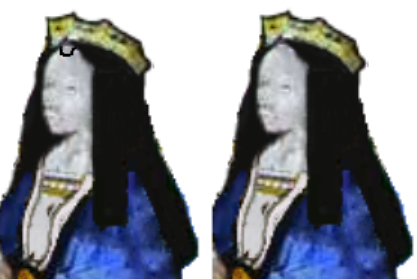
With or without u-band.
U-band on forehead occurs in gable hoods of 15th century. After 1505, the vast major women would long since have abandoned it. Like a decade prior.
Yet she was over 60, so i cannot rule out that granny who nobody would have dared to criticized-because she was mother of the king- would have gone around in something way out of fashion.
But then...she has no visible paste and that is consistent with 15th century too. Yet the gown is strongly against it.
So this is bit of contradiction, based upon just this small detail.

But who knows, maybe it is simply dirty in the most unfortunate of the spots and conicidently looks more like u-band, while it might be bit of hair showing.
I hope you have enjoyed this and tell me what you think.
3 notes
·
View notes
Text
Bit of architecture
I have recently been through album of architecture which British Library has on Flicker and decided to show you few interesting pieces I saw there.

The most interesting here is the cupola/skylight.

It might surprise you but those were already part of Tudor architecture, usually located in roof of the Great Hall. It is not as if all Tudor halls had them, but some did.
Second image is wharf and houses on bank of Thames:
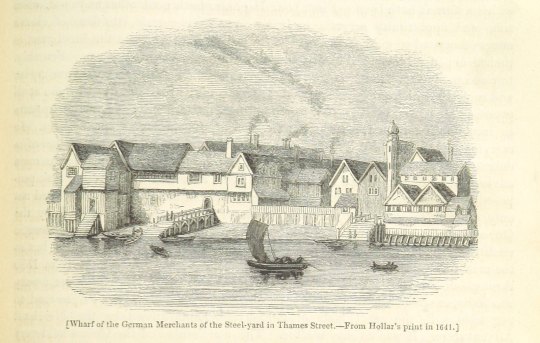
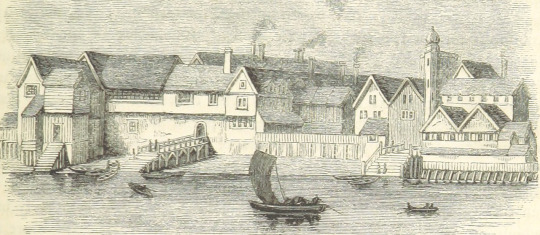
While this is from 17th century, big chunks of riverside London used to look like this in Tudor times also. I donnt mean the style of the houses, but what is before them.
-The wooden wharfs, various piers leading to the river-sometimes combined with bridge, lots of small boats being used. River was truly one of the major ways of transport.
Third picture shows Palacio del Infantado, Guadalajara in Spain:

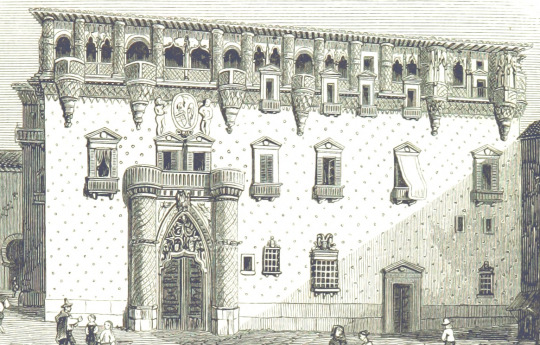
This was built in 1480-1483. That entire upper gallery and massive portal are great examples of Isabelline Gothic. Although the drawing cannot show how elaborate the stonework is in real life, because it is not photograph and there is simply too many little details of this elaborate style.
But when Catherine would be very little, the wealthy in Spain would be building such elaborate houses and her parents would also order buildings in such style.
1 note
·
View note
Text
Anne of Cleves in true colours


No, they sadly this painting has not been restored in true life as the one in Louvre recently was. This is me digitally removing the discoloured varnish, (Didnt have full success with hands.)+ the damaged upper edge. Trying my best to get it as close to original state as possible.
Before:

After i played with it:

Many poeple think it is copy after Holbein's portrait, claiming the outfit is basically same. But only the jewelry is same+elaborate chemise or under-parlet, but rest of the outfit isn't.
It might be an original by Holbein thought. Of all 3 versions of this portrait this has the best shot.
And you know...I will keep pointing this one out:

I will die on this hill. Tell me what you think.
9 notes
·
View notes
Text
Mary Tudor, Queen of France-another illumination
Artist unknown (French). Discours adressé au nom de l'Université de Paris à Marie d'Angleterre, reine de France, par maître « MAY DU BREUL », docteur en théologie., 1514. Parchment. Paris: Bibliothèque nationale de France, Français 5104. Source: BNF
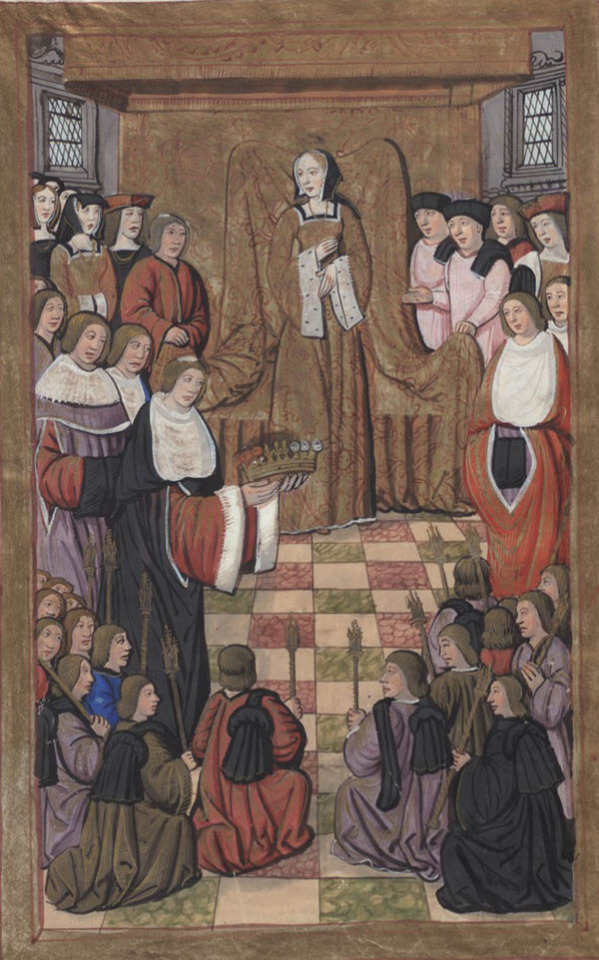
It translates as Speech addressed on behalf of the University of Paris to Mary of England, Queen of France, by master.
Her height in comparison to men on right is overexageration.

I mean she was described as tall and graceful(and this looks the part), but not as extra ordinary tall.
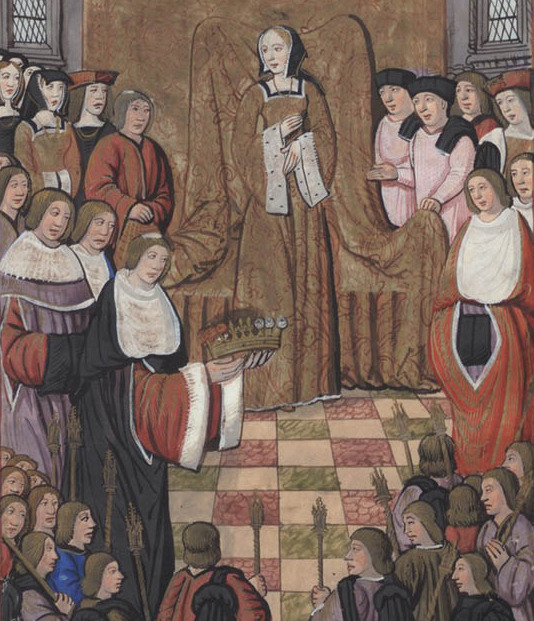
So she shouldnt be towering over them-at last not by this much. There are some other men in ilumination which also are disproportionally large to others(i dont think universities back then accepted children).
But note how pale she is in comparison to some of the other people around. Mostly only figures on upper left are this pale, while others have darker skintone. Whetever this is due to her naturally being this pale or artist trying to convey class to which those people belonged to, that i can't tell. I just thought it interesting, and the image might be used as another source of inspiration for her time in France.
17 notes
·
View notes
Note
Hope this works : https://i.pinimg.com/564x/40/e6/eb/40e6eb52d24dee59e597ca00f46bcddd.jpg
Original ask:People keep saying this is Frances Brandon, but looking at the fashion and the features of the sitter, I feel it's Katherine of Aragon instead. What are your thoughts?
(we didnt have the photo originally, but now i can finally answer this).

-My first observation regarding this painting is that it cannot be Francis Brandon, because she was born in 1517. This is 1500s or 1510s fashion of Netherlands. No way she could be depicted in fashion which is from before she was even born!
On wikipedia it is labelled Portrait of Agniete van den Rijne, atributed to Joos van Cleve, located in Rijksmuseum Twenthe in Enschede, in Netherlands. And as being painted in 1st half of 16th century.
On webpage of the museum, it is labelled as Unknown woman in c.1515. I suspect it could be bit earlier(split gown, large hanging chains)-my guess would be late 1500s, max early 1510s. But my chronology of netherlandish fashion was based upon court fashion. And neckline this low is consistent with some parts of Habsburg Netherlands, but not the court. So I could be bit off. But either way-1500s or 1510s imo. Not Francis Brandon. She wasnt even born when this was in fashion.
As for Catherine of Aragon.
Not that she couldnt wear netherlandish fashion(Sittow's portrait)-but a)when she did wear it, it was same fashion as in court.
b) what cut photos deliberately left out, is that this painting has its original frame...which includes coat of arms.

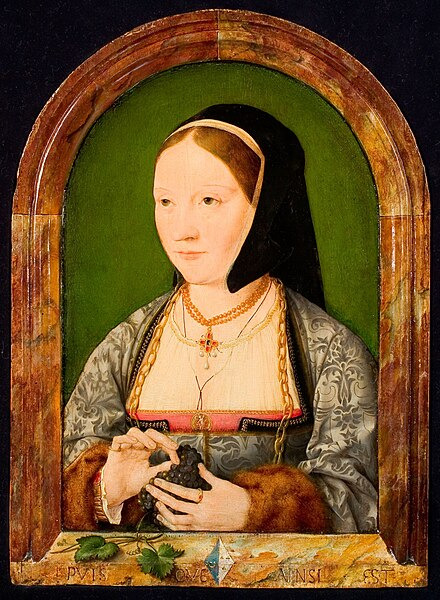
And experts believe this coat of arms to be original.

They havent been able to identify it nor of the man matching the woman. But clearly not Catherine's coat of arms.
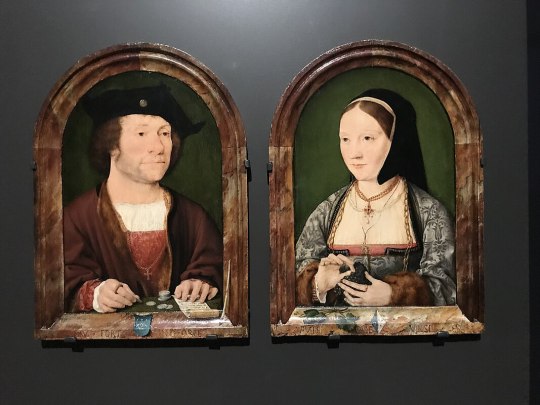
Also the focus here is on grapes-its fruit, its leaves and vines.
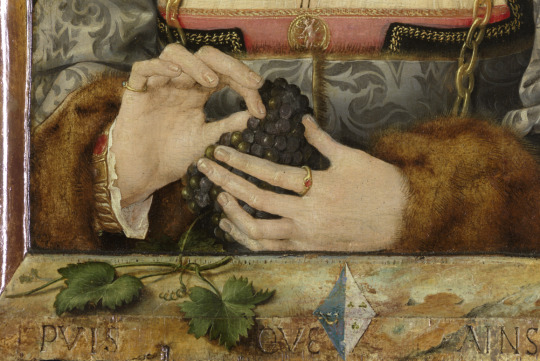
It is symbol of fertility and prosperity, as well as having several more meanings in christianity, but as far as i know never asociated with Catherine of Aragon specifically. And there is literally nothing to suggest it is her.
I agree that there is resemblence, but there is issue. The artist was skilled. So why upon closer inspection the nose looks so differently than hers?
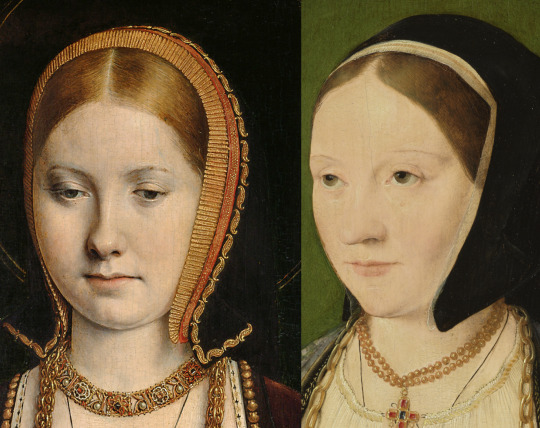
Catherine's nose tip seemed to be pointing more up and it was not as large. With some people-for example Margaret of Austria, size of nose changes as they age(due to health issues). However Catherine even in mid 1520s, still has narrow nose with tip basically same as in her youth.

Angle might play part a bit...but imo it is simply different nose.
The resemblence alone cannot drive identification. Not only do we not have single major clue pointing towards Catherine, we have major clue against her(coat of arms). Also Henry was likely painted by the artist when he met Francis I at Calais-with Anne Boleyn. The artist was asociated a lot with Francis, but never proven to travel to England or to take comissions from English royal court...aside that one meeting.
I am sorry, it is not Catherine of Aragon.
I am as upset as you guys that we don't have any surviving portrait of her from 1510s, and that many portraits we only know from not so great copies.
To find more lost originals, looking through art of artists which painted relatives of the person is indeed very good strategy. It pays off in many cases. Unfortuntely not in case of Joos van Cleve.
But it might be good idea to look up painters employed by Charles V and by Francis I in 1520-because Catherine met both that year.
Henry and Charles even had joined portraits made back then.

So there is indeed potential that some portrait of Catherine was created and it might have went with visitor. And it could have been another joined portrait because Charles didnt visit alone but with Germaine of Foix.
Problem is, the most likely thing for Catherine to wear in any portrait as Queen of England is gable hood- headwear unique to England. For her portraits to not be noticed, they would either have to be overpainted/altered, misidentified, misdated or even all three.
Another option is that upon meeting Charles that she wore spanish fashion. If she got painted in that, she wouldnt be that likely to be recognized.
Or maybe we need to broaden our idea of what Catherine wore.
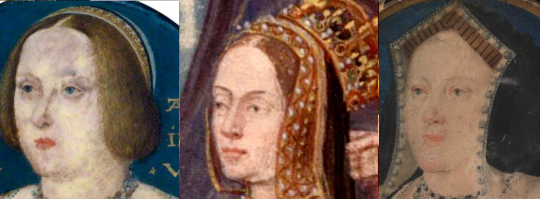
So my dears, the hunt is still on.
3 notes
·
View notes
Note
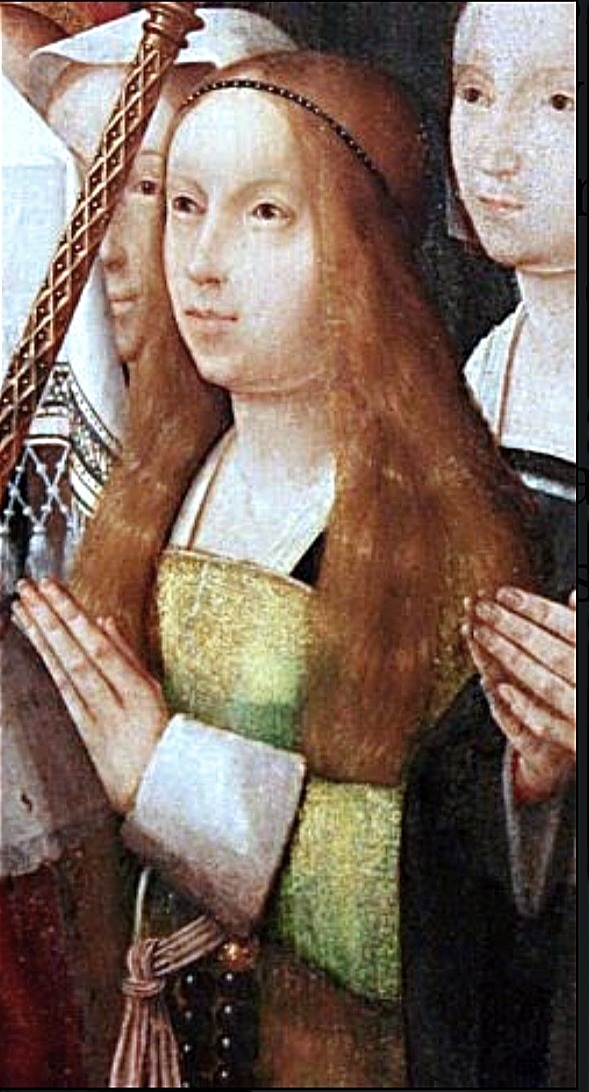
This is an imagen of María of Aragón, Queen of Portugal, from the Tríptico de Nuestra Señora de la Misericordia, Jan Provost, c. 1515.

I presume you wish to hear my thoughts about this painting, since no question was written.
Despite Jan Provoost never provenly leaving Low Countries, surprisingly not so small amount of his art are on Iberian peninsula.
Some of them provenly there since not long after their making, presumably comissioned directly. Not really sure how that comission process exactly worked.
Probably the best quality photos I could find of it are from this webpage.
Which also sheds bit of light about its history.
This painting is believed to be comissioned by Nuno Fernandes Cardoso and his wife Leonor Dias in 1511 when they had ordered construction of Chapel called la Capilla de San Juan de Letrán including the triptych for its altar. Thus it is presumed the painting was comissioned between years 1512-1515, not long after.
I have some issues regarding the royals within.
Number 1 all photos ignore the fifth presumed member of royal family-The girl in red dress on right.


(and fact two more figures are partially hiden behind the altar.)
It is believed by some that from left to right these are Manuel I, Maria of Aragon-his wife, Isabella of Portugal-his eldest daughter, Eleanor of Viseu(Dowager Queen of Portugal-wife of his predecessor) and Beatrice of Portugal-his younger daughter.
Not sure about costumes of everybody, but presumed daughters are dressed in Netherlandish outfits.
While i cannot rule out he was sent some sketches, the faces of these women are consistent with generic figures from other paintings by same artist. With designs which he was reusing.
Thus even if identification as royals is correct, it is not likely for it to be true likeness. (However in some cases, the artists were chosen because their already existing work reminded people of their loved ones. )
But the question on my mind seeing this triptych is-Where the heck are his sons? The painting is believed to be made in betwen 1512-1515.
By this point Manuel and Maria had 3 daughters and 5 boys. People were sexist back then, so idea King Manuel got depicted with wifey and daughters only is cute...but unrealistic.

While we have 7 male figures on left, one is pope(on right), one is old man, then there is monk(infante Henry was cardinal), and 4 more figures, not all of them even showing full face. They are not at front, but at back. Like is it symbolical...or were those boys not important?
Secondly, why would every royal except Manuel be depicted in clothes better fitted for somebody of lesser status?
Another depiction of the same royal family by Netherlandish artist Colijn de Coter is called Fons Vitae, and there despite outfits being netherlandish at least they were what we would expect from depiction of royalty.

Ermine, cloth of gold, crimson also popular with plenty of royals. But here only Manuel wears such suptuous robes.
(the other male with fur-that is not ermine, they specifically sewn those so that the tails appeared regularly.)

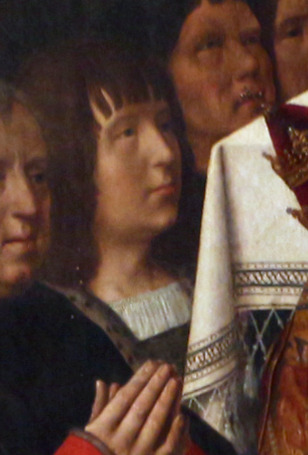
Thus i fear, it might be the case that Manuel is the sole royal depicted.
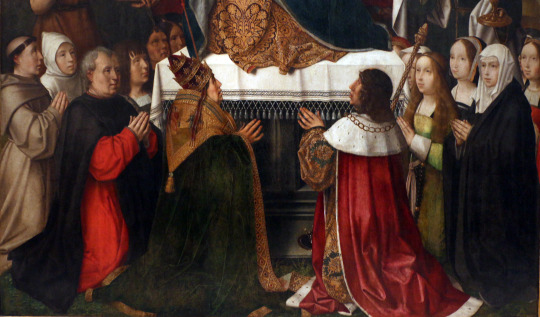
And that we have pope and king in central positions beneath Virgin Mary and people on sides will be the patrons and the family.
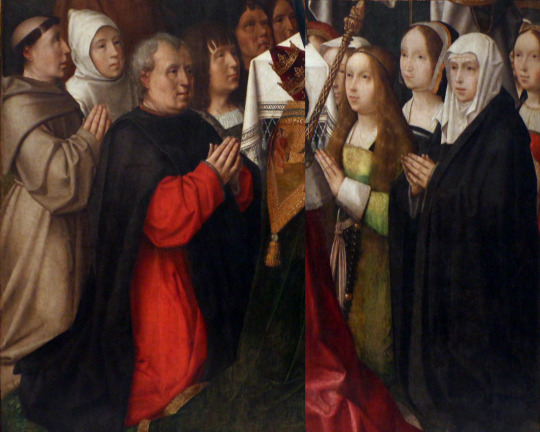
Possibly people who had the painting comissioned. Which would mean the grey-haired man in red and black is ment to represent Nuno Fernandes Cardoso(with his male relatives behind him).
And his wife Leonor Dias, is represented by either the woman in green or the woman in black with white headwear-which is also positioned probably the most at front(with the female relatives behind her.)
Thus in my opinion it could be the case of wrong identification, based upon proximity to the figure of the king and the fact the woman has golden hair (or at least i think she might have) and ribbon on upper part of forehead is bit similiar to how cofia the tranzado was worn with ribbon across forehead.
But even if i was wrong about this female not being ment to represent Maria, the face matches rest of generic saints by this artist. (for example the one on left)

Sorry. This is pretty face, but likely not Maria's.
3 notes
·
View notes
Note
People keep saying this is Frances Brandon, but looking at the fashion and the features of the sitter, I feel it's Katherine of Aragon instead. What are your thoughts?
I would like very much to answer this, but there was no image attached. Could you sent it again?
(Sometimes the issue is size of photo. Tumblr doesnt like files over certain size.)
1 note
·
View note
Text
William Carey and Mary Boleyn

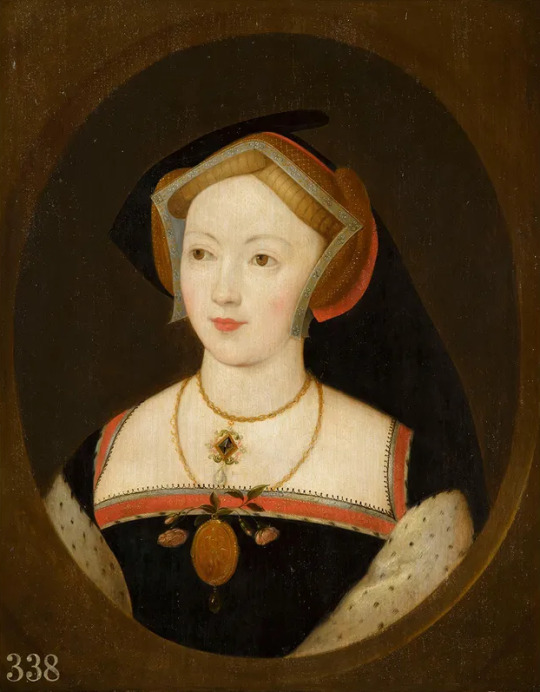
Per your request this post is dedicated to portraits of Mary Boleyn and her husband William Carey. And first thing you must be aware is that neither this portrait of William nor any of many versions of portraits of Mary are originals.
Large ovals nor large round portraits werent around in Tudor times. (Round miniatures existed.)
And Mary even as sister to the Queen never had status of royalty and wasnt supposed to wear ermine(parliamentary robes were exception). That is definitely alteration, yet it is in every single version of her portrait i know of.
I couldn't track down her original, but i found photo of William's. In which he wears lynx fur, not ermine. Much more apropriate for his status, and very often confused by people for ermine.

And it clearly says 1526, not 1528 as the copy of his portrait on wikipedia. And states he was 30 at the time, thus he was born in either 1496, or 1495. His outfit is very interesting, and i bet most you werent aware how elaborate some Tudor male outfits might be.
If colours in copies are to be trusted, the part with lines is from cloth of gold(which in lesser amount nobles were allowed to wear), combined with cloth of silver or shiny grey silk. Personally i am inclined to say silk, because it doesnt give metalic wibe.
This is 100% not Holbein's work(copy is said to be after Holbein), but possibly by artist which also painted this portrait of Henry VIII.
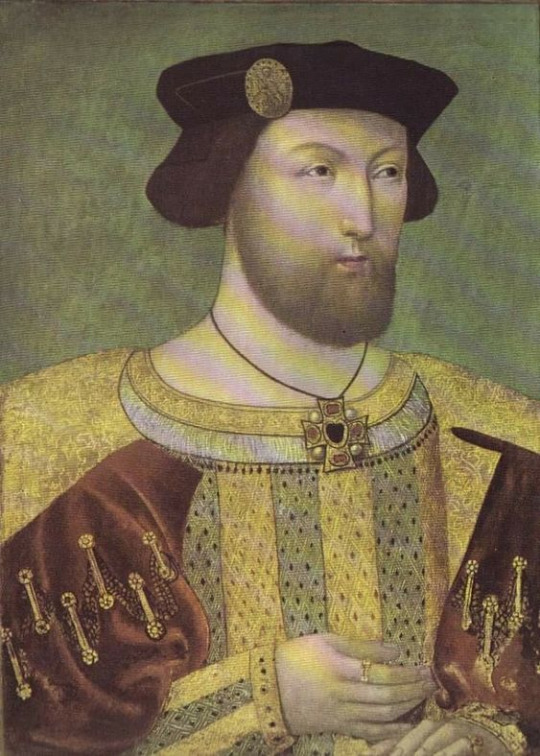
I have speculated it might be late workshop of Meynnart Wewyck. If it turned out to be true, then William's portrait would be proof the workshop was still around after 1525, when Wewyck disappears from records.But you know, Holbein's workshop was around for short while after his death also.
Only other painter which we know worked in England at the time is elusive Master of Brandon portrait(portraits by him bellow) in his work we see similiar basic shape of male fashion, yet nothing as elaborate, nor consistent with style of artist which painted Wiliam Carey.


Mary's portrait has at least 7 versions, not discovered by me but found by katherinethequeen.com.
Hever Castle,Warwick Castle, Holyrood Palace-Royal Collection Trust, Private Collection, Rockingham Castle, The Lord Wharton+ two more round versions.
But i want to share my observations upon them.
I have seen many copies of different portraits, and i find it very disturbing how similiar to each other they are.
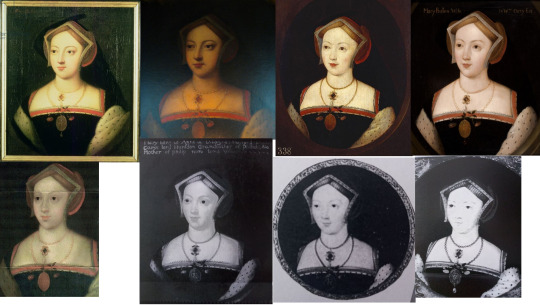
Naturally across centuries copies are created by different artists, and they all put their own mark upon it...and over time the some versions become unrecognizable from original.
Here most of them are carbon copies of each other. So much so, it wouldnt surprise me if majority were mass produced by same artist, or same workshop.
Royal Collection Trust has most information about their version. Stating Portrait of a Lady called Mary Boleyn, Lady Stafford (c.1499-1543) is from c. 1630-70, and it is atributed to Remigius van Leemput (d. 1675). He was both painter and art dealer.
You might for example know his copy of Whitehall Mural:

And observant person might notice some similiarities...between Jane Seymour in Whitehall Mural and alleged portrait of Mary.


I mean, if i just did few changes. It would become disturbing.






I am not sure of course, but I wanted to make you aware...it is possibility. Wouldnt even require that much effort on part of artist.
In 17th century the public interest in old art was big, especially for portraits of royalty or important figures from history. And sometimes art dealers created the 'new originals'(fakes), by getting inspired by existing art...and adjusting some details.
If it is a 17th century fake...then Jane Seymour is not the sole inspiration, another painting would account for rest of the details.
The artist had access to royal collection and other places, in 17th century most of Tudor portraits were still instact. It wouldnt be that hard for him to copy it. With only the size of medal being bit unsual, but not impossible. Ok, gable hood missing the paste ends-but it is missing from almost every copy.
Foliage pinned to medal is very accurate but often overlooked detail, found among Holbeins sketches, and some of his work. Maybe lynx was changed to ermine.
But overall this is historically accurate outfit, consistent with Mary's lifetime. So yes, it can still be her. I cannot rule it out.

But equally so it could be somebody else. Identification of Tudor portraits(or their coppies) originating in 17th century is totally unrealiable! By that point most misidentification already occured! By 1590s it was confusion all around, some even before.
(Of course we cannot rule out 17th century identification was based upon earlier identification, but that is hard to prove without the original.)
I also have to emphasize it is not match to her husband's portrait. Lynx vs ermine, could be minor alteration. But this is not gable hood consistent with 1526.
I don't know where they got idea the fashion within Mary's portrait fits c.1535 specifically, when this gable hood was around for more than ten years! (Since late 1520s to late 1530s/early 1540s. This shape of gown also, was around for very long time!)
So what shape of gable hood would be matching William?
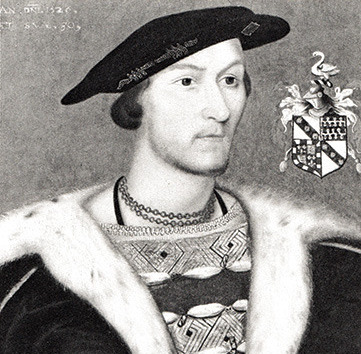
These two or in between:

On left c.1525, on right c.1526.
Both veils still down and split, very long ends of paste.
Now, she doesnt necessarily have to had portrait done at same time as her first husband. But William Carey was noted as art-collector, who is said to even introduce Lucas Horenbout to court.
Thus we would expect this lover of art to have portrait of his wife made alongside his own. Carey's love of everything good was however also bad thing because when he died in 1528, he left behind great debt and Mary even pawned her own jewellry. Thus chances that portraits he owned stayed within the family are not so great. But perhaps the portraits simply went their separate way.
If we could find portraits of same artistic style, of woman, maybe we would find Mary. In England matching portraits of husband and wives were a thing. Plenty of portraits you know are actually pair, from royalty:

to much humbler pairs:
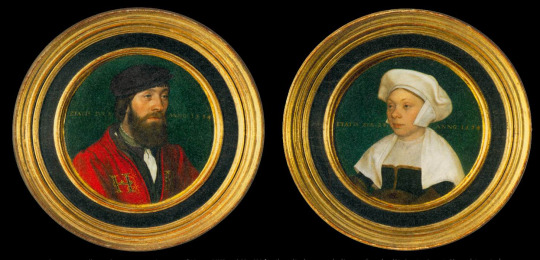
(Occasionally you find some which seem as pair at first and then you find out his wife was at least 20 years older than woman you see in the portrait...it is just inscription made by same person/artist within same year.)
But it would be greatly helpful, before we even start searching for Mary's matching portrait, to find William's original.
Isssue is, I lost it. I once found the photo of original on wikipedia and i am not sure if i saved it wrongly, or if it was time when my computer crashed and i lost all my saves. It has been several years, thus my memory of it is not great.
However, i was unable to find it again, search engine cant find him.
I vaguely recall i was going through some collection on wikipedia, lots of black and white photos. Maybe to do with art lost during WW1 and WW2? And i am not sure if back then that painting was labelled as him, nor if it was collection within UK or elsewhere. But it was recognizably this same original painting.
And it annoys me so much that i cant find it again. And we need to track down its location, and provenance, etc, to have clues as where Mary might went. And let us hope it also has coat of arms, date and age. That would be so amazing! To figure out who was the older sister.
Thus my question is: Does anybody know how to reverse search image on wikipedia?
Normal reseverse search engine come blank when it comes to any findings on wikipedia.
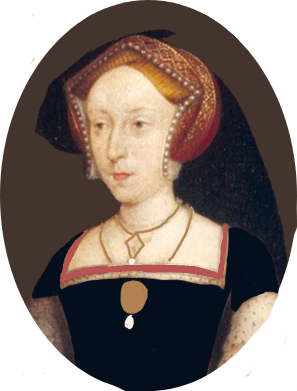
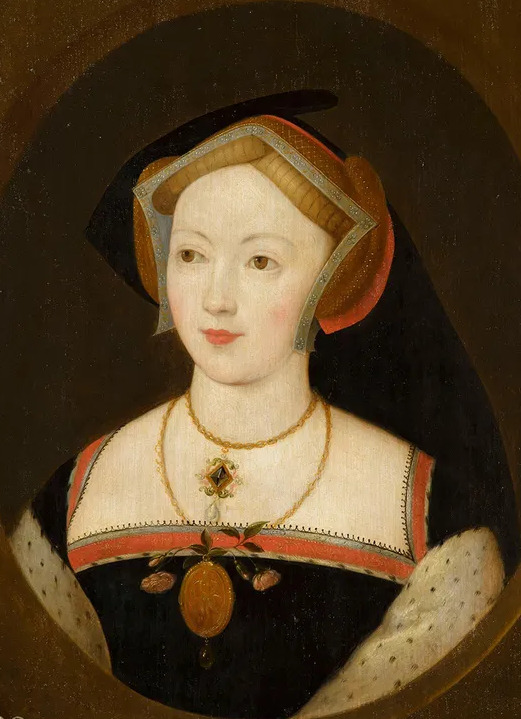
I hope this was of some interest to you, and let me know what you think.
16 notes
·
View notes
Text
If you couldnt find option which you like, write your suggestions down in comments.
1 note
·
View note
Text
Hiding in our sight this whole time


I actually thought the engraving by Hollar was based upon some lost portrait...but since most engravings are mirror images(engravers could be lazy ...), i decided to flip it...the outfit fits almost perfectly. the engraving just misess the chest brooch.
But some of you probably already noticed that.
Yet i doubt even most observant of you noticed that this unknown woman might be in another sketch by Holbein. Maybe.

These two have serious resemblence:
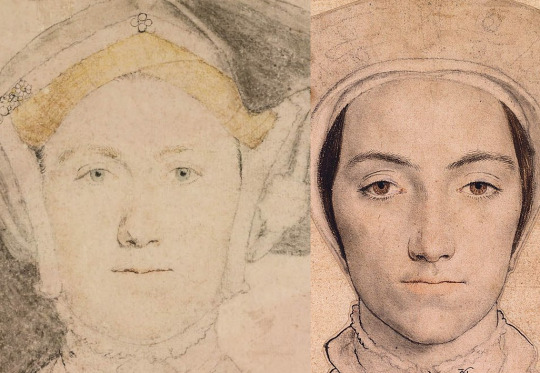
This is probably the strongest resemblence among all of Holbeins sketches.
The one on left is pretty worn off in face area and because lighter colours were used, without any lines enhanced in darker colours. This makes us think these arent connected. Until you compare features one by one.
Angle is identical, but tilt of head tiny bit different. Woman on right has gaze tiny bit more downcast...which might have exposed more of her eyelids, and also slightly affect shape of her brows. Try it before mirror.
I enhanced some shapes on woman on left:
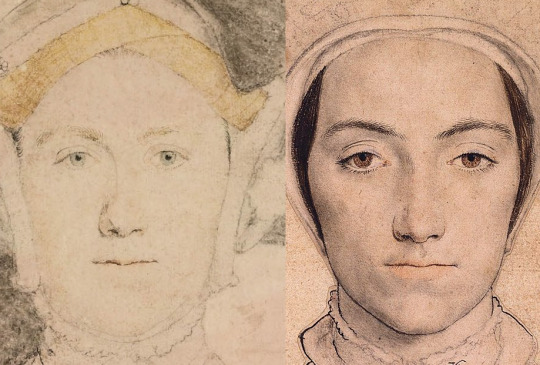
To make you realise she also similiar chin and shape of eyes as woman on right. Different colours and headwear play very big role here and might have something to do with eyes on right appearing bigger(maybe i didnt scale it 100% properly), the tilt shouldnt be causing that.
Could aging make her eyes bigger? Idk. I mean i don't know if % eyes take within the face changes. You of course overall get bigger as you age. But i wonder if perhaps just normal swollen eyes...account for difference. Not sure.
Yet the difference in size of eyes, alongside such strong resemblence could point also to very close relatives.
But size aside, can we explain different eye colour?
YES. We had this issue before with Tudor portraits...plenty of times.
With royals. Hazel eyes under differnet light can be brown or grey...significant difference even in real life, let alone portraits.
And they run in Henry's family, and seem to be his type...so among his wives too.
Woman on left wears gable hood in style fashionable between late 1520s to c.1538-1543. In past it was thought to be Catherine of Aragon or Eleanor Brandon.
While the other woman ix believed to be one of possibly marriage candidates from abroad, painted for Henry after Jane Seymour died, possibly sister of Anne of Cleves. Reasons for this assumption is the alleged bigger format(it is actually normal size for Holbein sketches...it is just that woman is sketched on lower part of drawing, instead upper part) and people believing woman is not wearing English clothes.
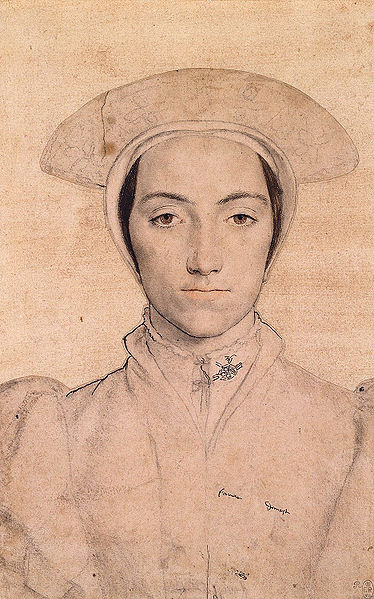
But actually this is English outfit. Mary Rose was depicted in such hat in 1510s. Coif beneath-worn in england.
Embroidered partlet-worn in england.
Cloak with slightly spread collar...worn in England.
It is true we rarely have portrait of women in cloak from England from Henry's reign. But it is idiotic to assume women in winter would walk around in same clothes as in summer. Fact that woman chose to be portrayed in it and puffiness around shoulder would suggest we likely indeed talk end of Holbeins career and fashion chaos of 1538-1543, because weather got colder-which affected fashion and ladies also experimented a lot during this timeframe.
While i cannot tell who it is, I just wanted to make you aware these two are likely connected.

Let me know what you think.
7 notes
·
View notes
Text
Another painting of Mary I+bit about portraits with cloth roll
While i am excited to find the auction painting was not known to most of you, of course majority of portraits of Mary I are copies of already known portraits. Still, i think it is good if we keep spreading information of all known versions, because then we are more aware what jewels were in royal collections and how royals looked under hands of different artists.
So here is version you might have not seen yet
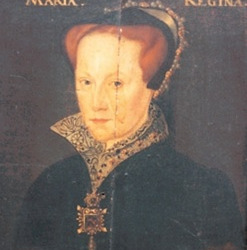
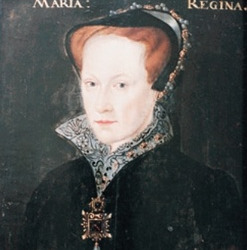
Painting on board before and after repair
I found it on this webpage:
Where it is stated the article is reproduced from The Building Conservation Directory, 2005. So i am not sure where the pictures originate and what is with copyright of them.
However clearly this is yet another painting with cloth roll beneath, and each of Mary's has different chest brooch. Interesting.
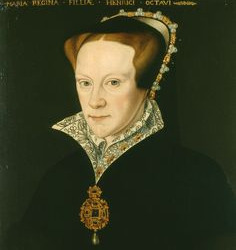
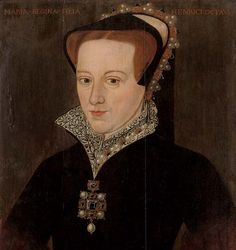
The original set of English Queens with cloth rolls was from 1560s and consisted of
-Mary I(above)
-Elizabeth of York



-Catherine of Aragon,


-Anne Boleyn,



-Jane Seymour
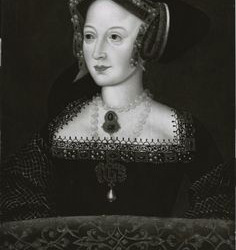
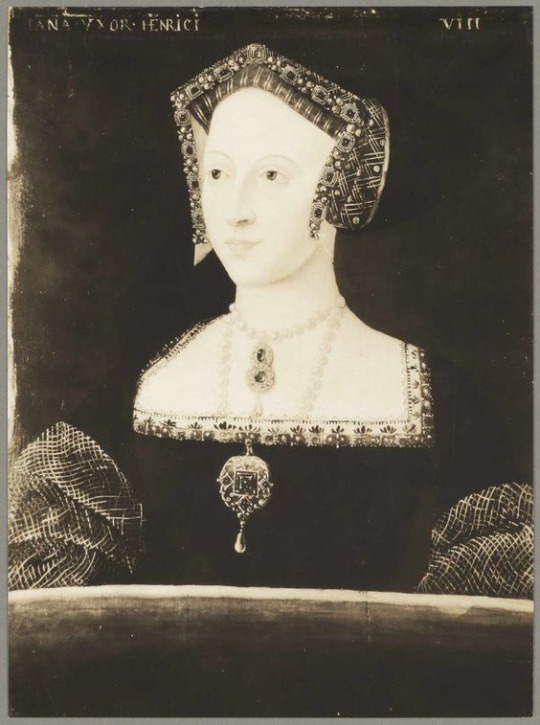
Possibly Elizabeth Woodville as well, though i am not sure if she wasnt later addition.
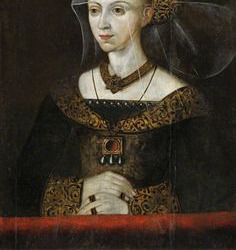
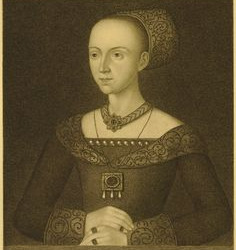
Because she is only depicted with plainer red cloth and that is the later set of paintings.

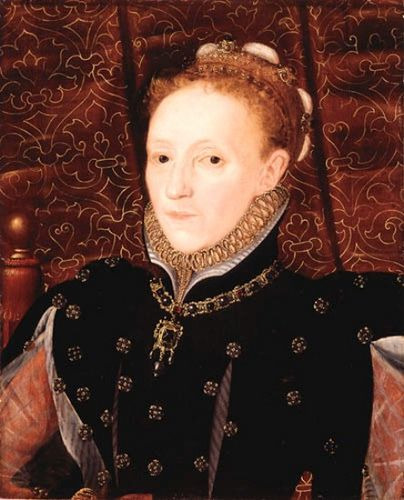
The fabric of the original set seems to match patterns popular in early reign of Elizabeth(which was likely mass produced pattern of fabric, sold across half of Europe).
Lastly...the portrait of Cecily of York with cloth rolls seems like a modern creation using the cloth roll from painting on right:


I hope you have enjoyed this, and if you guys know of any more versions of cloth roll paintings, write to me, send pictures, i will truly apreciate it.
11 notes
·
View notes
Text
I just found this portrait on mutualart.com
This is labelled there as unknown lady! When it is clearly Mary I as princess. Pri.Agl. Agl like Angliae?-latin for England

It is definitely her cross pendant with three pearls hanging, clearly her face, and she also tended to hold her hands this way in many portraits.
But obviously this is a copy and it has some innacuracies, few addons as well. Especially shape of her black dress seems off, as if somebody decided to just make up shape of her torso from scratch.
This is how i would imagine it was meant to look like:

Perhaps with black cloth girdle, hidden around waist by hands.
Link to the webpage, where you can see it in HD:
https://www.mutualart.com/Artwork/PORTRAIT-OF-A-LADY/C822211B4025F85E
I looked further and italian webpage to do with same 2021 auction, has actually labelled it as RITRATTO DI MARIA I TUDOR.
Portrait of Mary I Tudor. I take it back, they know who it is!
I searched for Mary's portraits in Spain, Austria, Netherlands, USA...but Italy really nope...but that is my mistake. The assumption that portrait in 500 years couldnt travel to completely different part of Europe is simply unwise of me.
PS: Have you ever seen this one before, am i only one unaware of it?
22 notes
·
View notes
Text
More mystery with portraits of Hasburgs
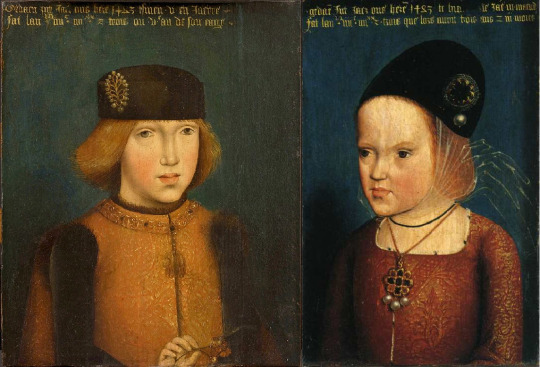
These two paintings are located in different museums, but are believed to be once a part. Currently they are labelled currently as Philip of Austria and Margaret of Austria, 1483, by Master of Legend of Magdalene.
And it's kind of a problem. Because at least the boy doesn't look like early work of this artist at all! Not even remotely close.
So other artists have been suggested instead, and for example the girl's has been most recently labelled as by Pierre Coustain.
Which doesn't make any sense either. Because while this was court artist in Burgundy, he specialized in making coat of arms and flags, sculptures etc. Like we can speculate on Pierre Coustain's involvement in these portraits(figures by Pieter van Coninxloo):

But only about the coats of arms. This guy wasn't portraitist.
...And you know me, I am nitpicker. I my motto is:
Never trust period label...because often times they are added centuries later.
So of course I checked the labels. On first glance, they seem as very genuine. This form of letters was around in 15 and 16th century.
...So I needed some help reading it, but luckily on wikipedia it was in description of paintings.
Girl's:

Gedaen Int Jaer ons here 1483 tsinen v en Jaerre/FAT LAN M.IIII.C.IIII.XX ET TROIS QUE LORS AUOIT TROIS ANS ET TROIS MOIS)
This was created in 1483 and she is 3 years and 3 months old.
(Very specific...oddly so.)

Gedaen Int Jaer ons here 1483 tsinen v en Jaerre / Fat Lan m. III c. IIII xx. z trois ou ve. an de son eage.
Once again it says year 1483, but that Philip is 3 or 5 years old.
Like how does nobody question this? You cannot be specific to month with girl, and not know how old the boy was!
Unless the label is not original at all! And likely not even done in 15th century. Because at those days, labels weren't really popular. They took off mainly in 16th century. And given the amount of mistakes I doubt Margaret nor Philip were even alive when this occured.
Because have they been, somebody would take greater care in getting it correct!
(And, If the text is from much later it is damn well-made.)
So if text is untrust-worthy, the dating of 1483 is also untrust-worthy, and then we cannot even be sure it is Philip or Margaret!

And though the boy doesn't fit Master of Legend's early work, he damn sure looks very alike to his late work! (1510-1527)
But then these kids cannot be royals from Netherlands. This is not its fashion from 16th century. We have portraits of Philip's kids raised in Netherlands, we know what they wore.
And while, yes the girl's hat looks bit like 1460-1470s male hats worn in netherlands, girls didn't wore this I checked. And given Netherlands were already back then northern capital of painters. It's very unlikely it wouldn't appear in art of that time from that country.
So possibly these are foreign royalty. But whom?
Well, artist started working around 1480/1490 and stopped about 1527. (Assuming we have correct artist.)
And the boy wears order of golden fleece around his neck. And clearly he is not adult. List of knights of Order of Golden fleece is on wikipedia and it includes when people got it and their birth year.
So finding people who got it before age of 15 in corrrect timeframe wasn't that hard.
Six candidates:
Philip of Austria (who it is currently identified as)
Henry VIII
Charles V
Ferdinand I, Holy Roman Emperor
Louis II, King of Bohemia and Hungary
Philibert of Chalon
But at age of 14 and 13, Henry VIII and Philibert are simply too old...to be depicted here. And Louis II's sister was older than he. And we know what Charles and his sisters raised in Netherlands wore.
Thus if not Philip and Margaret, the only other valiable option is Ferdinand and Catherine of Austria.
(if the list of candidates was complete...)
And it just so happens that if you put correct dimensions to these(in cm), and put them in order of birth, they don't look so weird...

Potentially this might have once been full set of siblings.
Done firstly around 1507(first four)
and rest after 1515, when Ferdinand became the member of the order.
...And if we compare what the girl wears with spanish fashion, then at least in examples from 1490s similiar hats were popular(not as much raised, but we always see them on adults. Maybe then the raise is not so high, and traluscent veils of this kind even much later(those are with cofia de tranzado)...this shape of neckline, also very popular in Spain at least around turn of the century.

In my research into iberian fashion, i didn't go that much into fashion after 1505(not in debt) and it's not ideal that I point to examples about 20 years prior to when I think it might be.
But it is a possibility, and would explain the resemblence.
...
However then we have to assume 2 more possibilities.
A) the list of knights of order of fleece was not complete...and we're missing candidates...and then once again, where does the fashion point us?...Spain in case of girl...
B) But what if the boy and girl don't belong together?
What if they just had same background(popular in Burgundian/Netherlandish court from 1450? to about 1507)
and same dimensions(by chance, or they were later cut to make them same dimensions)?
(C)what if both options? L)ist wasn't complete and boy and girl don't belong together?
Well, the boys who got orders of golden fleeces as kids were usually royalty, with whom Hasburgs had friendly relationship.
Only other option already not covered, would be either Christian II of Denmark-but he was made member in 1519-so he is on the list, as adult...
or John, Prince of Asturias and Girona. He married Margaret of Austria, in 1497 and died that same year. And Joanna married Philip of Austria in 1496.
We know Margaret's portraits were created in early to mid 1490s, likely to be sent to Spain, and probably Philip's also.
But what if Spanish send reply? And Hasburgs send their own painter, to paint Spanish royal children? That would also explain resemblence to Joanna's children. Because boy would have to be her brother, and girl Joanna herself.
Again, the boy seems to be later work of the master, but it was a workshop. It is possible one of its member simply became more prominent later in workshop's lifetime and it happened to be him who was sent to paint the boy.
And i cannot get further than this. Dendrology would be helpful here.
However as these portraits have year upon them, the institutions who own them think they have the correct date already. We can only hope they decide to test it anyway.
11 notes
·
View notes
Note
Hello! I was wondering about this squared headdress found in the More family portrait. Is it a French or English fashion?

Nowadays we(Tudor fandom) tend to call it the flat hood.
Long story short. We cannot safely determine its point of origin. It is for sure from N-W Europe, but it can be found in art across France, England and Netherlands, but doesn't seem to ever gain great prominance in either.
It is very similiar to french hoods, and often mistaken for it, and for that reason it is often overlooked and if you try to google it you will most likely get picture of kitchen flat hoods..not of the headwear.
Here are some more examples of it:
Portrait of a Husband and Wife, Philadelphia Museum of Art:

It is unclear where this portrait is from, because of damage to the coats of arms and fact that easiest recognizeable one(in woman's coat) Argent, a bend sable(white field, black bend) can belong to 3 ffamilies. Paynell(english), Raweneck(german) and La Barga(french).
But the dress could be English.
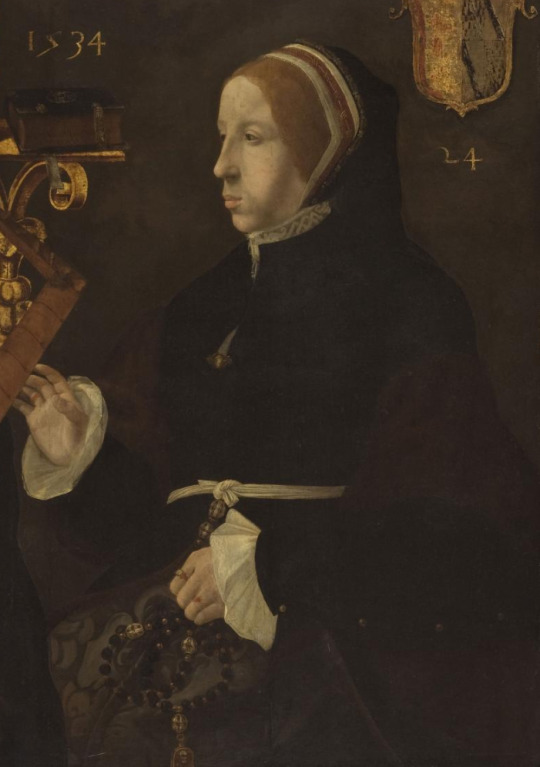
Mary Rose Tudor in 1514
if you look to the right of crown, just tiny bellow you will see the sharp edge, which should be on french hood.

Margaret of Austria(born in Netherlands), c.1505/6
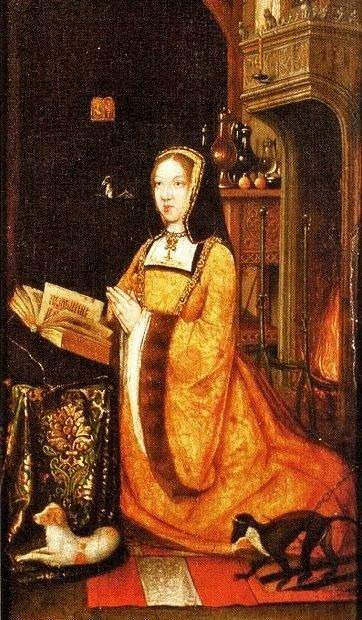
Then if we look at iluminations in-Ovide, Héroïdes, traduction d'Octavien de Saint-Gelais by French illuminator Robinet Testard, (working cca 1470-1531), which juding by the dresses probably originated in late 80s/early 1490s.
It is interesting it within same manuscript we have several different headwears:

1,3,4 all have same underlayer-this probably:

(minus the veil)
But we remove it...the differences are more visible(sorry about my poor fotoshoping skill):

1-is either flat or gable shaped cap, no veil-thus not true hood
It might be ancestor of paste of gable hood, which gives it is typical gable shape.
2-french hood with tranluscent veil at front, one typical early forms of french hood
3-french hood
4-flat hood, and likely one of ancestors of netherlandish suptype of french hoods

It is looking quite similiar to early forms of theirs.


Especially this one in close up:

But it is more round, than squarish in way that we associate with flat hoods.
What i am trying to say is that the headwear originated in 15th century already, probably around same time gable and french hoods did.
Thus if we wish to use it for recreation of outfit of somebody in England, yes we could already put it to reign of Henry VII-perhaps without that firm top, but we have to try to mimic style of french or gable hoods of the time...because those headwears evolved together, correlating to surprising degree.
But who knows, maybe it was around even before.
For example this one, If it is ment to be gable hood, then tip of gable is in wrong spot, but had it been flat hood it is correctly done:
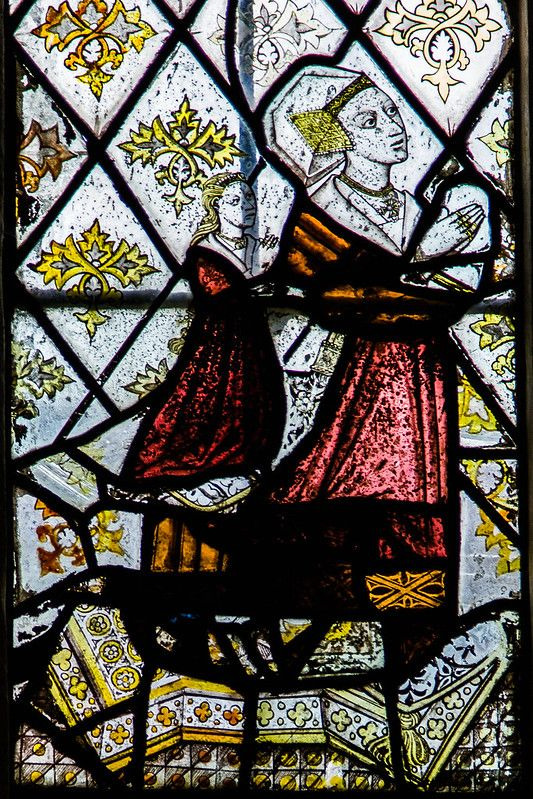
I personally like flat hoods very much, their shape and all.
Unfortunately the amount of surviving depictions of it, point to it never being historically very popular in its own right.
Thus use it sparsely.
But then, we have great lack of surving portraits+other depictions from other countries from N-W Europe, hence we cannot rule out it wasnt popular in those.
PS: Now who wants to bet that in next 7 days I will find something which will make rethink everything which I just wrote?-Because usually it is the case.
If you know of more examples of this headwear(aside from Holbein's work), I would love for you guys to send me link.
10 notes
·
View notes
Text
My new video is out
youtube
It is insanely long, 20 minutes...but i think i covered everything...or at least i hope so. Hopefully this will clear out some of the confusion regarding Anne Boleyn's true looks.
Tbh researching thre records was very frustrating to me, took me several weeks...and especially frustrating was realising that so many people haven't researched what she wore on the most important day of her life...(spoiler!).
I was sick for 6 weeks towards end of year...the covid is nasty b...even when it is milder form, it keeps coming back...over and over again... But i am finally healthy again...so expect some new posts soon.
Regarding some of my artwork(if we can call it that) used in video, i dont mind if you use it. Although i am not entirely sure how it is with copyrights of the most happy medal, so beware there.
This one is based upon it:
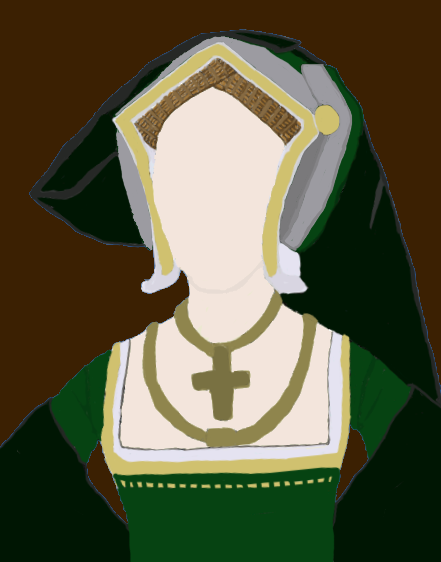
the stripy fabric on gable hood has truly intricate pattern in the medal, but the bodice was smashed pretty bad, as was jewelry...and face of course...thus we cannot tell exact shape of them, nor of that decorative line on her chest...what that was supposed to look like. i expect something similiar to embroidery on Jane Seymour.
B pendant/necklace portrait:

the necklace is obviously ment to be from pearls...i made it in just grey lines...but what surprised me is that i am not sure if the side lines/necklace is truly the golden chain as in most versions...or if it is another line of pearls...
This one is based upon Chequers' ring:

and i took creative liberties with the pendant(there was literal gemstone in that place), other possibility would be to have chest brooch with large pearl...but normally those have pearls hanging down from it, not on top...i am not sure if some chest brooch was there or not.
also many lines were smudged and hard to tell apart(bilements on french hood), and i suspect that since the necklace is quite regular on left side...that it is ment to be also on right side, that the damage caused the irregularity.
But what absolutely needs to be repeat again...we have yet to find original inspiration for that ring...we have missing Tudor original...and we should be on lookout for it. And since the ring is too damn tiny for most people to realise what is even there...i created this, so you would have better visual clue.
Also here is Hall's chronicle if you wish to check it out for yourself:
5 notes
·
View notes
Text
St. Barbara by Lucas Cranach the Elder
Lucas Cranach the Elder is not among painters we associate with Netherlandish art. However, he made the trip in 1509, and painted Emperor Maxmilian and future Charles V during the occasion.

While we have no prove he painted also netherlandish royal ladies, it is clear they inspired the St. Barbara(above) which he painted around same time. C.1509-it is excellent example of netherlandish fashion from that time...and very suitable as costume inspiration. Except the halo of course. :-)
It's quite rare we can tie painting to specific year, but that makes it even more valuable in terms of creating chronology of fashion for specific country. And I am very gleeful that this fits to my chronology- late 1500s/very early 1510s.
The saint Barbara in this golden outfit is left wing of portable artalpierce(triptych) belonging to Landgrave Wilhel of Hesse an Anna of Mecklenburg.
Which is also called-Jesus flanked with Saints Barbara,left and Catherine,right,1509 Lucas Cranach:

If you want to see the painting in more detail, here is the link:
PS: I forgot to say that this stripy embroidery is reminisense of spanish embroidery(examples more bellow)
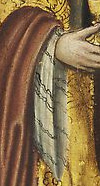
(Update-i have no idea why this image shows so large. The picture i put in is no larger than my thumb. It's probably some glitch. Sorry.)
and thus probably brought into Netherlands by Joanna I of Castile or Margaret of Austria's time in Spain as Princess of Austurias(both happening in late 1490s). I don't recall another example of this, in netherlandish fashion, so far.


But I'd expect that at court it could have lingered for bit, especially among royals women. Margaret and Joanna's daughters.
7 notes
·
View notes
Text
Troubling portrait of Maria of Aragon
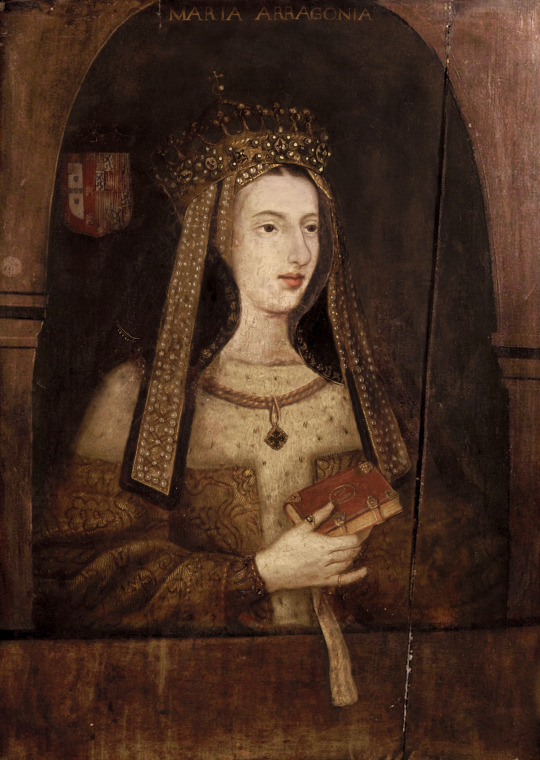
Not everything is that well with this portrait and I am not going to pretend otherwise. I marked it for you what is wrong:

(Pink-suspicious, orange-original outlines, red-altered, dark red-physically impossible for those layers to exist simultanously!)
This is crazy! What the hell is going on?! ...Let's find out.
I hope this will fit single post(tumblr has limits regarding amount of pictures you can post.)
Now, about the painting.The amount of alterations I can spot, is disturbing.

The headwear is mixture of netherlandish subtype of french hood, and english gable hood, as if somebody put them together:

(my photoshoping skills are not good enough to make them 100% accurate, but you get the idea...)
Yes, in France and I think also in Netherlands you can find some examples of frontlets on french hood-in cca 1480s and early 1490s. Afterwards...nope. And this one...has the bejewelled part surounding face typical for english gable hood ...and I've never seen it in historical examples of these combining.
And in closeup it's obvious the layers cannot even physically fit together...Literally impossible.

Because these frontlets have black base upon which decorative part sits...and it's obvious the fronlet is supposed to go ABOVE the veil french hood..., so french hood should go UNDER it...but the pattern on french hood goes ABOVE the base of frontlet. It's literally impossible for that to happen simultanously.
One or both have to be altered. But which? Idk!
Futhermore there is dark shadow behind the current edge of veil, which indicates the outer edge of veil was moved, making it more narrow.

But if it was wider it'd be consistent with both netherlandish subtype of french hood and english gable hood:

Neither was that flat at the back. And neither would be worn by Maria. Furthermore, the netherlandish headwear is of style of copies based upon her sister Joanna's headwear. It's not historically accurate style. The gable hood...well, in form which we see now, it is also not historically accurate. Yet at same timethere is bigger level of realism than I'd expect if it was completely made up.
Hence I started to suspect that actual portrait was inspiration for this peace.
If we look at the portrait further we can tell that outer edge of dress was also moved, making shoulders more narrow and more femine, and one shoulder has no ermine, hence likely ermine area was extended.

Imo the high of neckline is also altered, I am highly suspicious of it...because even in England and Netherlands it was not worn so high, in Iberia absolutely not! This neckline would only make sense in very cold countries. In Scandinavia, Moscowy etc.
But there are more things I am suspicious about.
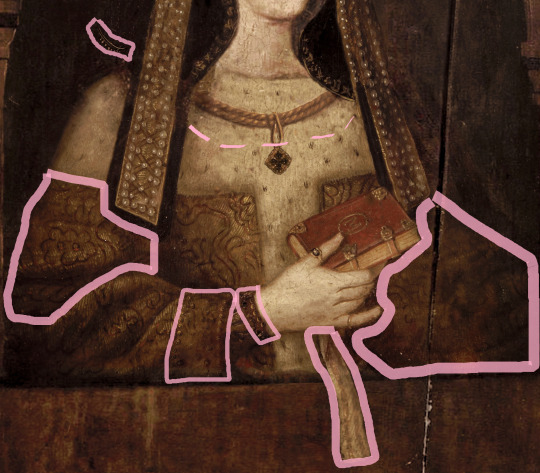
Little detail on veil of french hood(occasionally hapens, but not much in 16th century)...anyway it is probably just minor decorative add-on. But this part of cloth of gold looks photoshopped:

These bits, the way pattern is similiar...nearly identical, looks photoshopped:

In program which I use(photopea)...there is tool which allows you to copy the pattern and move it around ...and then you can create things like this. You'd need to just play with it bit afterwards, to blend it in...and in one spot it's not even done.
This is very disturbing for me. Especially given what wikipedia says about the painting.

Date of creation is XXI meaning 21. Like 21st century? Is it just modern creation made in computer?
... I created one such fake for April fools post... and I too deliberately played with shadows to make it look like it was altered...
I cannot rule this possibility, but it could also be case of bad photo, or bad printing. Because the wikipedia also says that source of image is a book called Infantas de Espanha, Rainhas em Portugal:
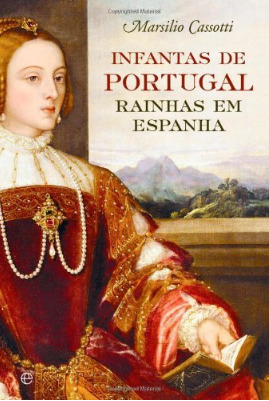
So could it be that there was so problem in printing process? Or something went wrong with photo?
Or...that the portrait itself is real...but it had some ugly paint loss and they decided to fix it in photoshopp to make it more pleasing to look at the book?
All of these are possible.
Additoonally, the arm on right(from our POV) seems to be moved in such position as if away from the painting...which could indicate it was originally larger.
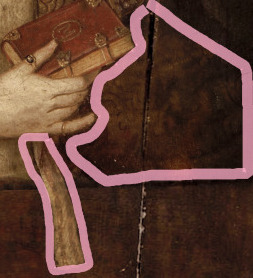
And while the ribbon being held is not that impossible, fact that it goes over the ledge suggest it is not an accurate detai, but alteration.
More details I am suspicious about are all in same area around the 2nd hand.

These decorative round things...if they are supposed to be pearls...they look nothing like the one on headwear, yet if we mark their positions, they look as if trying to copy that pattern:

Furthermore the shadows are bit off in this area. There are parts which are lighter in colour...which could be if originally there was ermine edge to the dress...which was overpainted. Unfortunately I can't tell from these what shape exactly it'd have...
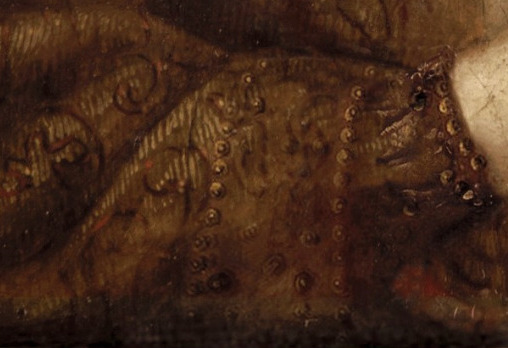
So after seeing all of this...what is my opinion on this?
I cannot confirm the portrait is real. But...I don't think anybody would be able to create this in photoshop without having something real to work with. I think there is portrait like this...and the level of alterations...the oddities...suggest it has been altered a while ago.
I cannot rule out photoshopped was used in part of it, but I think rest exist in real.
Does it mean it is accurate or that it is Maria? ...No, and given the level of alterations, it's not likely the head was spared...
On occasion though it happens. For example portrait of Infanta Isabella Clara Eugenia, Archduchess of Austria(b.1566)

who is supposed to wear the Franciscan habit of a Poor Clare(like on left), but in portrait (on right) somebody added lady Margaret Beaufort's headwear(probably) and changed some other details too.
Could it be the case of Maria's portrait too?
Well...in theory yes. Somebody could add english and netherlandish headwear to her portrait.
Could altered possibly heck out of the dress too, thus removing Iberian fashion from Iberian portrait.
Could photoshop it(possibly.)
... Or perhaps somebody created new portrait based upon Maria's portrait and Joanna's and Elizabeth of York's? (Puzzle of 3.)
Or some other option.
The face, the coat of arm, text and M on book could have been added to make it clearer that it is Maria...or could have been used to make it Maria. WE SIMPLY DO NOT KNOW!
...BUT we cannot play ostrich...and pretend that everything is fine with this portrait. Because it is not.
And if we remove all things which are weird, what is left of this portrait? A hand?!

(I didn't know how far ermine extended, so i left it like this)
...Hold on...
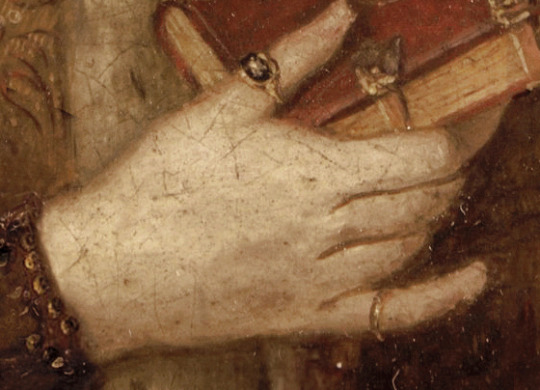
You've got to be kidding me. I recognize it. I recognize the hand!
...Well, not this hand but the style of the hand...the way the fingers are drawn/painted.
No way...no it can't be...Let me check.

...Maybe it could be. I have speculated there was one...and it'd make perfect sense. Wide shoulders, hand across chest, cloth of gold with ermine...the reddish girdle...
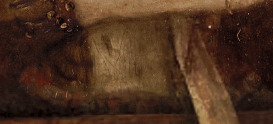
the ledge...the round top. ...I should have seen it front first glance!
The only real problem is that is facing the wrong way! It's flipped from the normal position.

But if you flip it back it's obvious. It's same outfit as in Whitehall Mural:
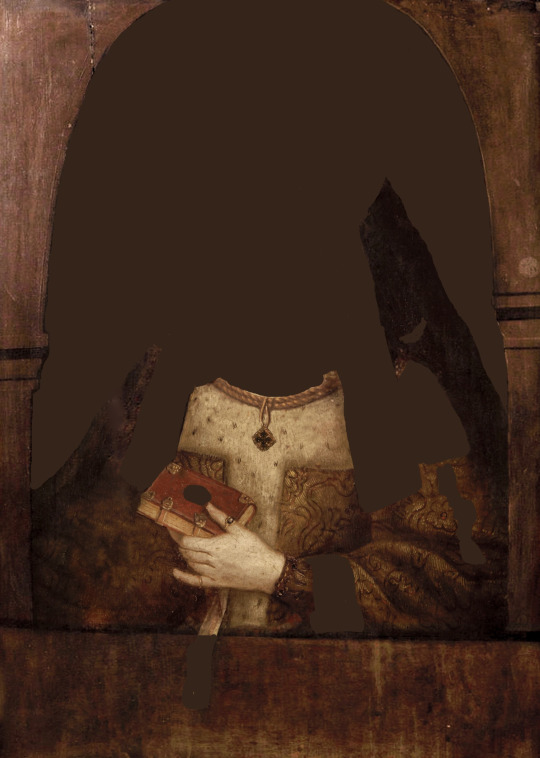


Even the reddish/pinkish girtle!
The the other hand is of Henry VII, in drawing which I speculated could have been by Wewyck's workshop(although it is not confirmed):
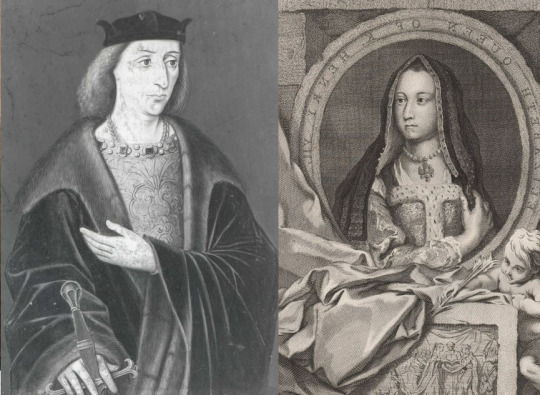
And I have also said it's likely there was once Elizabeth's portrait which matched his. With one hand across chest and the other extended downwards bit to the side!

This could be altered portrait of Elizabeth of York...with yes, some major alterations...but it's not the most common image of hers...it looks to be based upon rare image of her, of which we have no copies or no good copies of...
Yes it is facing wrong way...but it's not 100% rule.
Which could mean...that we're looking at altered original.
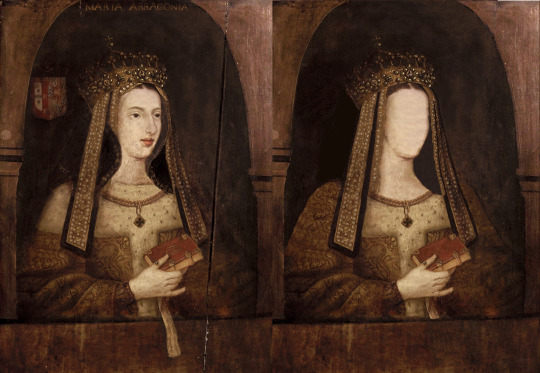
Which tbh if we consider it could be Elizabeth, wouldn't need to be even altered that much(and I didn't need to remove that much), and majority of the changes would be done to hide her thicker neck and wider shoulders.
...You know I have been suspecting certain spanish artworks to be based upon English royal portraits...but I thought...how would they get hands on it...well maybe Henry VII and catholic monarchs were exchanging portraits of their family members...
And if so...there might be more english portraits waiting to rediscovered on iberian peninsula...
But I could of course be wrong...but none of this points really to Iberian peninsula. It's too toward N-W fashion.
What do you think? Am I correct or am I chasing shadows?
17 notes
·
View notes